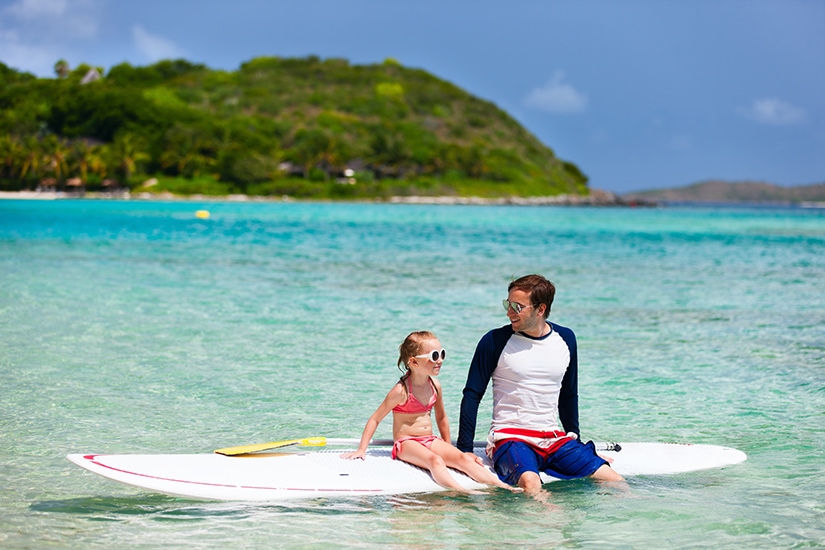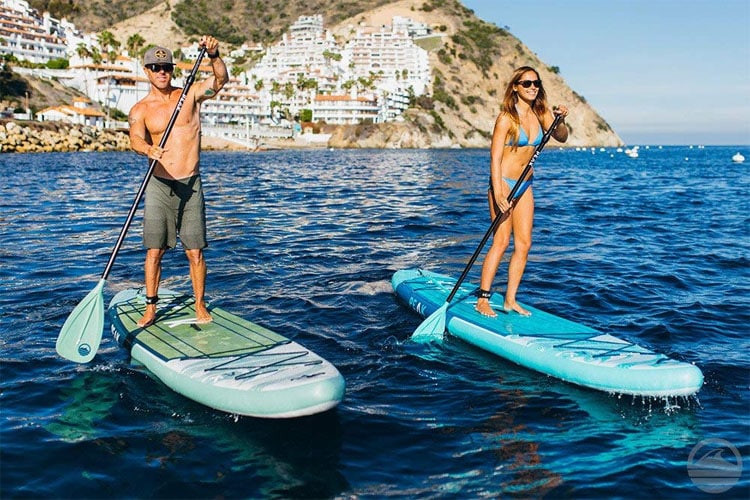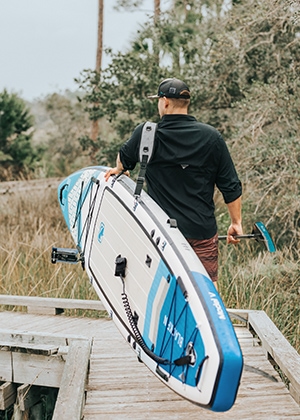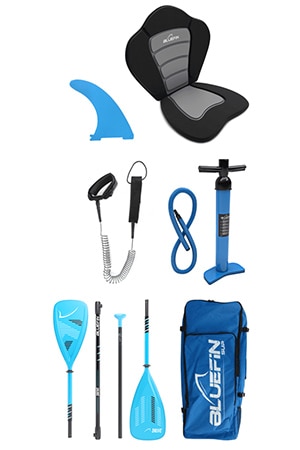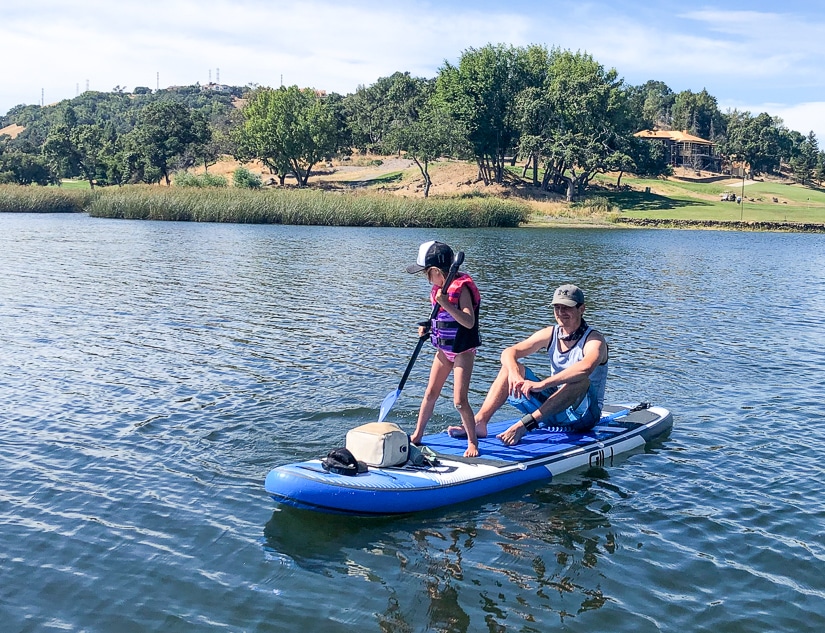Why are paddle boards so expensive? With the rise in popularity, it seems like everyone around you is picking up paddle boarding. They appear to be having fun so you think, why not try it yourself? You go online and you are taken aback by the prices. You don’t expect a paddle board to cost that much.
Many people expect stand up paddle boards to be cheap—cheaper than kayaks even. But when you start looking at the prices, you will be surprised. Some paddle boards cost as much as $2500 and more.
So, what makes paddle boards so expensive? Let’s find out.
Key Takeaways
- Standup paddle boards range from about $200 up to around $3000, so their price can vary considerably – but you’re very unlikely to get a quality board for under about $500
- The higher the quality and cost of materials used, the higher the price of the paddle board. And bigger boards cost more than smaller ones because they use more materials.
- More often than not, paddleboards come with accessories. Most inflatable boards come with a bag for the SUP, manual pump, leash, and a paddle. Some solid paddleboards come with a paddle, SUP bag, leash, and/or carry strap – so you’re paying for a package, not just a board.
- The demand for paddle boards is high and it will, most likely, continue to be. This demand influences the retail price
Are Paddle Boards Really Expensive?
Yes and no. First, it depends on your definition of “expensive”. Some people don’t consider $1000 to be too much for a paddle board, while others can’t imagine coughing up that amount.
Secondly, it depends on the stand up paddle board you are buying.
The truth is, you can get SUPs for as low as $250 or less. Cheap paddle boards are not hard to find, especially inflatable ones.
RELATED: Read our best budget paddle board reviews.
Generally, the price of standup paddle boards ranges from about $200 to $3000+.
And you know what they say, you get what you pay for. Lower prices, in many cases, show that the manufacturer sacrificed something to lower the production cost.
So I’d say, yes, quality paddleboards are costly.
Why Are SUP Boards So Expensive?
1. Supply and Demand
In 2013, stand up paddle boarding was recorded as the sport with the most first-time participants in the USA. According to Channel Signal, SUP-related Google searches have increased exponentially. And they are expected to continue rising. Surprisingly, that wasn’t the case with other watersports at the time of this research. Their Google searches seemed to be dropping.
Standup paddleboarding is here to stay. People have come up with variations such as SUP yoga/fitness, paddle board fishing, paddle board touring, and much more. Don’t forget that paddleboarding is a fun full-body workout with tons of health benefits.
What all this means is that the demand for paddle boards is high and it will, most likely, continue to be.
When the demand for a commodity is high, the prices will probably be high as well. And if the demand exceeds supply, the prices will rise—simple economics.
While there are many paddle board manufacturers, not all of them are reputable. And not many people want a cheap SUP that will burst when left under the sun. They are willing to pay $800+ for a good paddle board. So why would the sellers drop the prices?
Many paddleboarders are also buying multiple paddle boards. They want to paddle with their friends or families. It gets crazier during the summer when everyone wants to be outside and in or around the water.
As long as the demand is high, the prices will continue to be high. Fortunately, more manufacturers are entering the scene. The prices have been dropping over the years.
2. Paddle Board Construction
Another reason why paddle boards are so expensive is that SUP boards are not as simple as they seem. A lot of work, materials, and technology go into making them.
The construction of an inflatable paddle board is different from that of a solid paddle board.
Let’s take a look at each one separately.
a. Inflatable Paddle Boards Construction
All blow-up paddleboards are the same at the core. They feature dropstitch construction. There are two fabric layers attached using many small threads. The purpose of the threads is to enable the inflatable paddle board to maintain its shape when inflated and not bulge.
Now, the dropstitch material is anything but airtight. So a PVC layer is applied to seal the air in.
Don’t zone out. Here lies the answer to your question.
Some manufacturers stop there. As you can imagine, an inflatable paddle board like this will not be very reliable. That is why some iSUPs flex in the middle or explode when left under the sun for too long. They can also get dented easily. You can get these boards at very low prices.
Quality inflatable SUP boards, on the other hand, go a step or two further. They could have four layers of dropstitch fabric, two at the top and two at the bottom. Others include extra layers of PVC—dual-layer, triple-layer, and quad-layer.
In addition to that, the manufacturers may reinforce the rails using PVC layers, multiple rail bands, and techniques such as heat welding.
Read more about inflatable paddle board construction here.
With the extra materials, technology, and labor, the production cost goes up—and so does the price.
Although quality inflatable paddle boards are expensive, they are worth it. First, the manufacturers stand behind them 100%. Bluefin boards, for instance, come with a five-year warranty.
The inflatable paddle boards are virtually indestructible. You can find all kinds of crazy durability tests on YouTube. Here is an extreme one from Red Paddle Co (now you know why their paddle boards don’t come cheap).
b. Rigid Paddle Boards Construction
Solid or rigid paddle boards typically cost more than inflatable paddle boards—but there are exceptions.
Almost all rigid paddle boards feature a foam core. It could be polyurethane (PU) or expanded polystyrene (EPS). The latter is lighter and more durable.
This foam is then wrapped using carbon fiber, fiberglass, plastic, or heat-laminated polyethylene.
Some of these materials are more expensive than others.
Plastic paddleboards can either be hollow or have a foam core. Although it is an extremely durable material, plastic is super heavy. But as far as the cost goes, paddleboards made with this material are among the cheapest. Plastic is easily accessible and the manufacturing process is not that complex.
Next, we have what you know as soft-top paddleboards. These have a foam core and then heat laminated polyethylene on top. Like plastic paddleboards, they aren’t very expensive.
When you get to fiberglass, carbon fiber, and wood paddleboards, the prices start getting serious.
Carbon fiber is super stiff. Expect a carbon-fiber paddle board to glide with remarkable speed. It is also very responsive. When it comes to performance, carbon fiber boards are unmatched. Add to this the fact that carbon fiber is expensive. The prices of these boards can range from $1500 to $3000+.
Fiberglass and wood paddleboards are also quite expensive, with some costing as much as the carbon fiber SUPs.
Read more about rigid paddleboards construction here.
So why do solid SUPs cost that much?
You see, a carbon fiber paddle board is not just foam and carbon fiber. There is a lot that goes into making a wood, fiberglass, or carbon fiber SUP durable and beautiful. Yes, people care about the appearance of their paddleboards.
Besides, many people want a tough stand up paddleboard that is also lightweight.
These SUPs feature multiple layers like wood veneer, epoxy layers, finishing, and, of course, a traction pad. Paddlers may request custom designs, especially with wooden SUPs. This raises the price even more.
So the higher the quality and cost of materials used, the higher the price of the paddle board. And bigger boards cost more than smaller ones because they use more materials.
3. Accessories
More often than not, paddleboards come with extra features and accessories. Most inflatable boards come with a bag for the SUP board, manual pump, leash, and a paddle. Some solid paddleboards come with a paddle, SUP bag, leash, and/or carry strap.
All these things cause the price to go up. And many of them come as a package. You can’t get the paddle board without the accessories.
The quality of accessories determines how high the price will be. If the paddle is made of aluminum and the leash is basic, the paddle board won’t be expensive. But things like carbon paddles, high-quality bags, and ultra-comfortable leashes raise the price.
Some of these accessories are more expensive than some of the cheap paddleboards.
You may also like our Bluefin Cruise SUP review.
4. Marketing and Distribution
In addition to the manufacturing cost, add marketing and distribution costs.
The manufacturers have to let potential customers know about their boards. This could mean paying influencers and other marketing strategies. None of which are free.
Then there is distribution. The companies have to make a profit so they add that to the production and marketing costs. And it gets even costlier if you don’t buy directly from the manufacturer.
When a wholesaler buys from the company, they add their profit to the original price and sell to a retailer. The retailer, in turn, will add their profit to the wholesale price. All these costs add up quickly.
Luckily, you can buy straight from companies like iRocker and Atoll. Cut out the middle man and reduce the price.
5. Stand Up Paddle Boarding Is Still a New Sport
There aren’t many paddleboards in circulation, compared to, say, kayaks. Most people are still enjoying their SUPs. They are valuable and you can hardly get a good used one. Many paddlers have to opt for new paddleboards. And this takes us back to the supply and demand issue.
Additionally, many manufacturers still don’t produce paddleboards in bulk. Most of these companies are small and family-operated. Producing a large number of SUPs is cheaper than producing one single paddle board or several SUPs. You can buy the raw materials in bulk at a discount and automate some of the processes. Then the price wouldn’t be very high.
How Can You Get Quality Paddle Boards at Cheaper Prices?
A quality board is expensive. But if you are on a tight budget, there’s a way to save money.
Get rid of the middle man. Instead of buying from a retailer, why not purchase your board straight from the manufacturer? Go to their website and find the board you want. You might get free shipping and even a discount.
Wait for sales. You can buy awesome paddleboards for half their prices during sales. Wait for Black Friday, holiday, and end-of-year sales and you save money. They sometimes have great paddleboards for less than $500.
Don’t buy during summer. That is when everyone else wants to buy a paddle board. You can get amazing discounts just after summer.
So, Why Are SUP Boards So Expensive?
1. Supply and demand: the demand for SUPs is currently high since more people are getting into paddle boarding.
2. They are not cheap to produce: quality boards require quality materials, advanced technology, and skilled technicians. Putting all those layers together to give you a durable and rigid paddle board is expensive.
3. Accessories: SUPS that come with quality accessories will be more expensive.
4. Marketing and distribution: these processes are not free.
5. Stand up paddle boarding is still new.
Do you have any questions or comments? Please let us know below. Happy paddling!

